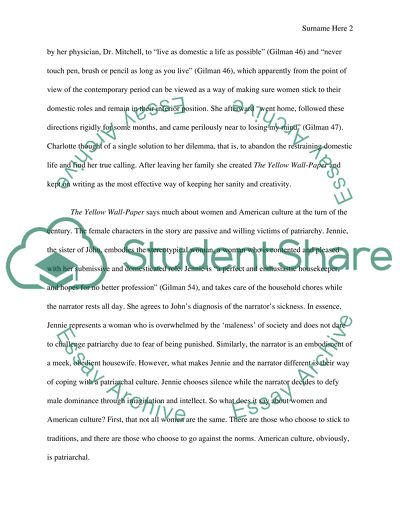Cite this document
(“Consider The Yellow Wallpaper as a feminist text. What does the work Essay - 1”, n.d.)
Consider The Yellow Wallpaper as a feminist text. What does the work Essay - 1. Retrieved from https://studentshare.org/literature/1621962-consider-the-yellow-wallpaper-as-a-feminist-text-what-does-the-work-say-about-women-and-american-culture-at-the-turn-of-the-century-how-does-the-wife-defeat-the-patriarchal-culture-represented-in-the-attitude-of-her-husband
Consider The Yellow Wallpaper as a feminist text. What does the work Essay - 1. Retrieved from https://studentshare.org/literature/1621962-consider-the-yellow-wallpaper-as-a-feminist-text-what-does-the-work-say-about-women-and-american-culture-at-the-turn-of-the-century-how-does-the-wife-defeat-the-patriarchal-culture-represented-in-the-attitude-of-her-husband
(Consider The Yellow Wallpaper As a Feminist Text. What Does the Work Essay - 1)
Consider The Yellow Wallpaper As a Feminist Text. What Does the Work Essay - 1. https://studentshare.org/literature/1621962-consider-the-yellow-wallpaper-as-a-feminist-text-what-does-the-work-say-about-women-and-american-culture-at-the-turn-of-the-century-how-does-the-wife-defeat-the-patriarchal-culture-represented-in-the-attitude-of-her-husband.
Consider The Yellow Wallpaper As a Feminist Text. What Does the Work Essay - 1. https://studentshare.org/literature/1621962-consider-the-yellow-wallpaper-as-a-feminist-text-what-does-the-work-say-about-women-and-american-culture-at-the-turn-of-the-century-how-does-the-wife-defeat-the-patriarchal-culture-represented-in-the-attitude-of-her-husband.
“Consider The Yellow Wallpaper As a Feminist Text. What Does the Work Essay - 1”, n.d. https://studentshare.org/literature/1621962-consider-the-yellow-wallpaper-as-a-feminist-text-what-does-the-work-say-about-women-and-american-culture-at-the-turn-of-the-century-how-does-the-wife-defeat-the-patriarchal-culture-represented-in-the-attitude-of-her-husband.


